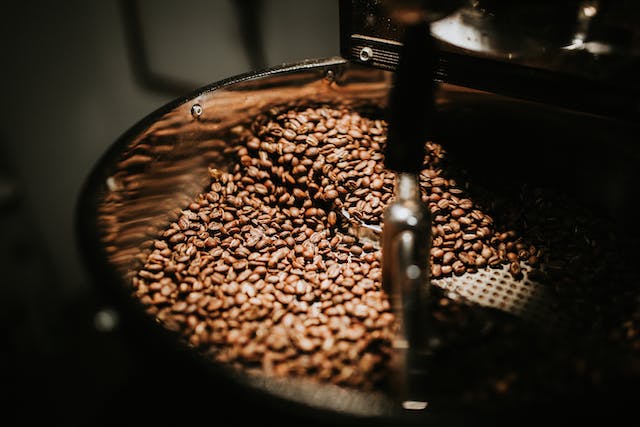Looking to perfect your roasting skills? From understanding the intricate chemical reactions during roasting to mastering the various roast levels and profiles, this guide offers a comprehensive look at the artistry and science behind your favorite brew. Whether you’re a coffee aficionado, a budding home roaster, or simply curious about the process, prepare to be immersed in the fascinating world of coffee roasting.
The Art And Science Of Coffee Roasting
Unlocking The Aroma
Picture this: green coffee beans entering a roaster, where they begin a remarkable transformation. It’s about unlocking a treasure trove of flavors and aromas hidden within. At the heart of this process is the Maillard reaction, a culinary alchemy where heat coaxes the beans to reveal their full potential, giving us the delightful flavors and scents that make our morning cup so special.
The Warm Embrace
Heat is the unsung hero in our coffee’s journey. It’s not just about cranking up the temperature; it’s a delicate balance that determines whether our coffee will be a smooth, light delight or a deep, dark brew. The secret lies in how the beans absorb this warmth. The roasters’ skill in managing this heat transfer is crucial. They ensure that each bean receives the perfect amount of warmth, leading to a uniform roast and a flavor profile that hits all the right notes.
The Flavor Alchemist
Now, let’s dive a little deeper into the Maillard reaction, the flavor alchemist of the coffee world. This is where amino acids and sugars in the beans have a little dance at high temperatures, creating a symphony of flavors ranging from caramel to chocolate, even nutty undertones. The magic lies in the roasting time and temperature – this is where a roaster’s expertise shines, crafting the perfect balance to bring out the best in each bean.
Balancing Act
Roasting is a balancing act. As the beans roast, their natural acidity mellows, while their inherent sweetness blossoms. By tweaking the roasting time and temperature, roasters can play with these levels, crafting a cup that can range from bright and tangy to smooth and sweet. It’s this careful calibration that ensures each sip is a delightful experience.

Crafting the Perfect Cup
Roasting coffee is an art form, a delicate balance of time and temperature that brings out the best in every bean. Each level of roast – light, medium, and dark – offers a different story in terms of flavor, body, and aroma. Let’s take a closer look at these roast levels and the journey of developing the perfect roast curve.
Light Roasts
Imagine a light roast as a delicate ballet of flavors. These beans are roasted for a shorter period, just enough to reveal their true essence. It’s in light roasts that the bean’s original character shines brightest – bright acidity, whispers of floral and fruity notes, and a gentle, almost ethereal body. Light roasts are for those who seek to explore the bean’s passport – its origin, variety, and the tales it has to tell.
Medium Roasts
Now, picture the medium roast as the perfect middle ground. These beans are given a bit more time in the roaster, emerging with a richer medium brown color. They’re the diplomats of coffee, offering a balanced profile – not too light, not too dark.
Here, the acidity mellows, and the flavors deepen into notes of caramel and chocolate, creating a fuller body. Medium roasts are often the choice of those who seek a harmonious cup, one that respects the bean’s natural flavors while embracing the transformative touch of roasting.
Dark Roasts
Dark roasts are the bold, dramatic finale. Roasted the longest, these beans don a dark brown coat, often with an oily sheen. They speak a language of intensity – smoky, with a hint of bitterness, a low acidity, and a heavy, lingering body. Dark roasts are the choice for those who crave a robust, commanding flavor, often forming the backbone of many espresso blends.
Mastering The Roast Curve
Developing a roast curve is akin to composing a symphony. It’s about understanding each bean – its origin, variety, and potential. The roast curve is a roaster’s blueprint, guiding them in how to apply heat over time to unlock each bean’s full spectrum of flavors. This process is a blend of science and intuition, requiring skill, patience, and a lot of experimentation.

Finding Your Ideal Coffee Roaster
Start by assessing your needs: consider the quantity you plan to roast, your skill level, and your preferred roast types. For personal or small-scale use, a smaller roaster might suffice, while commercial operations require larger, more advanced machines.
When looking at types of roasters, drum roasters offer versatility and are suited for various roast levels, making them a good all-rounder. Fluid bed roasters are ideal for beginners or those preferring lighter roasts, thanks to their straightforward operation. For larger operations, commercial roasters offer high capacity and precise control but come with a higher price tag and complexity.
Key features to consider include control and customization options, ease of use, maintenance requirements, and of course, budget. The Aillio Bullet R1 V2 from Current Crop, for example, is renowned for its precision and is suitable for those who want detailed control over their roasting process.
The Final Roast
Embarking on the coffee roasting journey opens up a universe of flavors, aromas, and experiences. From the alchemy of the Maillard reaction to the precision of picking the perfect roaster, each step is a blend of art and science, intuition and technique.
Whether you are experimenting with roast profiles or selecting the ideal roaster for your needs, remember that each choice you make adds to your unique coffee story. As you continue to explore and learn, let your senses guide you through this ever-evolving and rewarding craft. Enjoy the journey, one roast at a time.




